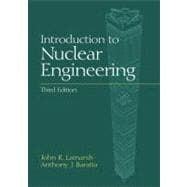
Anthony Baratta is currently a Professor of Nuclear Engineering at The Pennsylvania State University and Director of the Nuclear Safety Center. He received the B.A/B.S. degrees in physics/applied physics from Columbia University in 1968 and the M.S. and Ph.D. degrees in physics from Brown University in 1970 and 1978, respectively. His research interests and contributions include reactor safety, reactor kinetics and physics, and the effects of radiation on materials. He has authored many scientific publications and made numerous presentations. He is an active member of the American Nuclear Society and has appeared on many network television and radio broadcasts as an authority on reactor accidents, including the accident at Three Mile Island.
|
1 | (5) | |||
|
5 | (47) | |||
|
5 | (2) | |||
|
7 | (1) | |||
|
8 | (3) | |||
|
11 | (1) | |||
|
11 | (3) | |||
|
14 | (1) | |||
|
15 | (3) | |||
|
18 | (4) | |||
|
22 | (4) | |||
|
26 | (3) | |||
|
29 | (4) | |||
|
33 | (4) | |||
|
37 | (3) | |||
|
40 | (12) | |||
|
44 | (1) | |||
|
45 | (7) | |||
|
52 | (65) | |||
|
52 | (2) | |||
|
54 | (3) | |||
|
57 | (3) | |||
|
60 | (2) | |||
|
62 | (6) | |||
|
68 | (6) | |||
|
74 | (16) | |||
|
90 | (10) | |||
|
100 | (17) | |||
|
109 | (1) | |||
|
110 | (7) | |||
|
117 | (113) | |||
|
117 | (2) | |||
|
119 | (10) | |||
|
129 | (4) | |||
|
133 | (3) | |||
|
136 | (49) | |||
|
185 | (16) | |||
|
201 | (16) | |||
|
217 | (2) | |||
|
219 | (11) | |||
|
223 | (1) | |||
|
224 | (6) | |||
|
230 | (36) | |||
|
230 | (1) | |||
|
231 | (4) | |||
|
235 | (2) | |||
|
237 | (1) | |||
|
238 | (2) | |||
|
240 | (6) | |||
|
246 | (2) | |||
|
248 | (4) | |||
|
252 | (5) | |||
|
257 | (9) | |||
|
260 | (1) | |||
|
260 | (6) | |||
|
266 | (61) | |||
|
266 | (5) | |||
|
271 | (3) | |||
|
274 | (8) | |||
|
282 | (4) | |||
|
286 | (11) | |||
|
297 | (11) | |||
|
308 | (1) | |||
|
309 | (18) | |||
|
320 | (1) | |||
|
321 | (6) | |||
|
327 | (76) | |||
|
328 | (2) | |||
|
330 | (18) | |||
|
348 | (17) | |||
|
365 | (11) | |||
|
376 | (13) | |||
|
389 | (14) | |||
|
397 | (1) | |||
|
398 | (5) | |||
|
403 | (63) | |||
|
404 | (4) | |||
|
408 | (9) | |||
|
417 | (11) | |||
|
428 | (13) | |||
|
441 | (9) | |||
|
450 | (16) | |||
|
457 | (2) | |||
|
459 | (7) | |||
|
466 | (82) | |||
|
467 | (1) | |||
|
468 | (8) | |||
|
476 | (3) | |||
|
479 | (6) | |||
|
485 | (10) | |||
|
495 | (4) | |||
|
499 | (7) | |||
|
506 | (5) | |||
|
511 | (15) | |||
|
526 | (9) | |||
|
535 | (13) | |||
|
539 | (3) | |||
|
542 | (2) | |||
|
544 | (4) | |||
|
548 | (64) | |||
|
549 | (10) | |||
|
559 | (7) | |||
|
566 | (5) | |||
|
571 | (2) | |||
|
573 | (3) | |||
|
576 | (2) | |||
|
578 | (6) | |||
|
584 | (4) | |||
|
588 | (2) | |||
|
590 | (5) | |||
|
595 | (4) | |||
|
599 | (5) | |||
|
604 | (8) | |||
|
605 | (1) | |||
|
606 | (6) | |||
|
612 | (149) | |||
|
613 | (1) | |||
|
614 | (9) | |||
|
623 | (8) | |||
|
631 | (19) | |||
|
650 | (19) | |||
|
669 | (12) | |||
|
681 | (20) | |||
|
701 | (9) | |||
|
710 | (21) | |||
|
721 | (2) | |||
|
723 | (8) | |||
| APPENDIXES | |||||
|
731 | (6) | |||
|
737 | (8) | |||
|
745 | (6) | |||
|
751 | (6) | |||
|
757 | (4) | |||
| Index | 761 |
The New copy of this book will include any supplemental materials advertised. Please check the title of the book to determine if it should include any access cards, study guides, lab manuals, CDs, etc.
The Used, Rental and eBook copies of this book are not guaranteed to include any supplemental materials. Typically, only the book itself is included. This is true even if the title states it includes any access cards, study guides, lab manuals, CDs, etc.